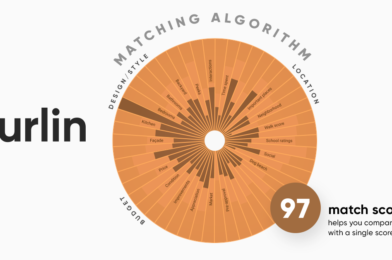One good and bad bit of COVID-related real estate truth is that the process has been given a hard shove into the virtual. The move does help fill the in-person void created by new social distancing norms, and virtual tools will forever be part of a “more efficient process.” But has the home-finding calculus changed for the better, or is the value mostly entertainment provided by fun technology? Is there a matching algorithm for finding the right home? The black and white TV is now color. The coat hanger antennae replaced by cable. Game Shows replaced by Game of Thrones. You are still sitting on your couch.
The Reality of Finding the Right Home
We created a new level of home matching that touts new tech, but our fancy algorithm is more than just fun, it actually solves the problem in a new and actionable way. We wanted make matches based on you, not everyone like you, wanted. We wanted to reframe the process, to consider non-practical factors and how images and interactions could contribute to the experience and the result. We wanted to respect, and create, the emotional value of finding the right home. And we wanted to get you off of the couch.
Here’s the gist of it. First we reverse the process by starting with the components of design and desire rather than a list of loosely fitted pragmatic calculations. We personalize your profile based on the images and styles in the places that you like, the comparisons you make, the ones you save and ones you spend the most time considering. Maybe it’s the layout of a kitchen in a Manhattan Beach Mediterranean, for instance, or the décor of a bathroom in Malibu. Missing from current “intelligent” solutions is an understanding that the joy of finding a home is as much seeing what you are looking for, as it is the delight of discovering something new. Results are generalized and static. We follow you on a path of design discovery and continuously which will likely lead us to new places impossible to know at our first meeting.
Rather than confining your options by zip codes or neighborhood boundaries (which are increasingly ambiguous and evolving) or a single point of reference, like commute distance, we start with what’s important to your life and lifestyle, your daughter’s soccer, your son’s cello, your social outlets and access parks and beaches.
The final trick of our fancy algorithm is when it really gets real. Your match score is informed by the details of what’s in your budget to buy or rent or upgrade the homes you like, including pre-approval status.
No Mental Math Required
The magic is the math we do for you. We’ve trained our AI to trust and learn from the data in images rather than dubious text descriptions. It does a multivariate analysis of a myriad of data points, which mindfully accounts for the migration of your preferences, considerations and options and simulates a trade-off analysis for you. The above Matching Algorithm chart transparently visualizes the system. Notice the conspicuous absence of popularity factors.
The bunny in the hat is the match score, which reveals the best fits for you based on and including both emotional and practical priorities.


















 So far in 2018, more new listings have been featured in California’s housing market than any year since 2008. If you’ll remember, that was the year of the financial crisis that rocked most industries, including real estate. In that year, there were only 10% more new listings for the same period compared to this huge jump in 2018.
So far in 2018, more new listings have been featured in California’s housing market than any year since 2008. If you’ll remember, that was the year of the financial crisis that rocked most industries, including real estate. In that year, there were only 10% more new listings for the same period compared to this huge jump in 2018. From January to September 2018, houses have spent an average of 19 days on the market. This is the lowest recorded number of days on the market since 2008, though it has been steadily declining since then.
From January to September 2018, houses have spent an average of 19 days on the market. This is the lowest recorded number of days on the market since 2008, though it has been steadily declining since then. In this seller’s market, having the ability to conduct a fast, zip-code-agnostic, real-time search aligned with your unique preferences and budget is critical. If you are forced to complete your search through typical web apps that require a mass of manual labor on your part, you simply won’t be able to act fast enough to secure a home.
In this seller’s market, having the ability to conduct a fast, zip-code-agnostic, real-time search aligned with your unique preferences and budget is critical. If you are forced to complete your search through typical web apps that require a mass of manual labor on your part, you simply won’t be able to act fast enough to secure a home.

